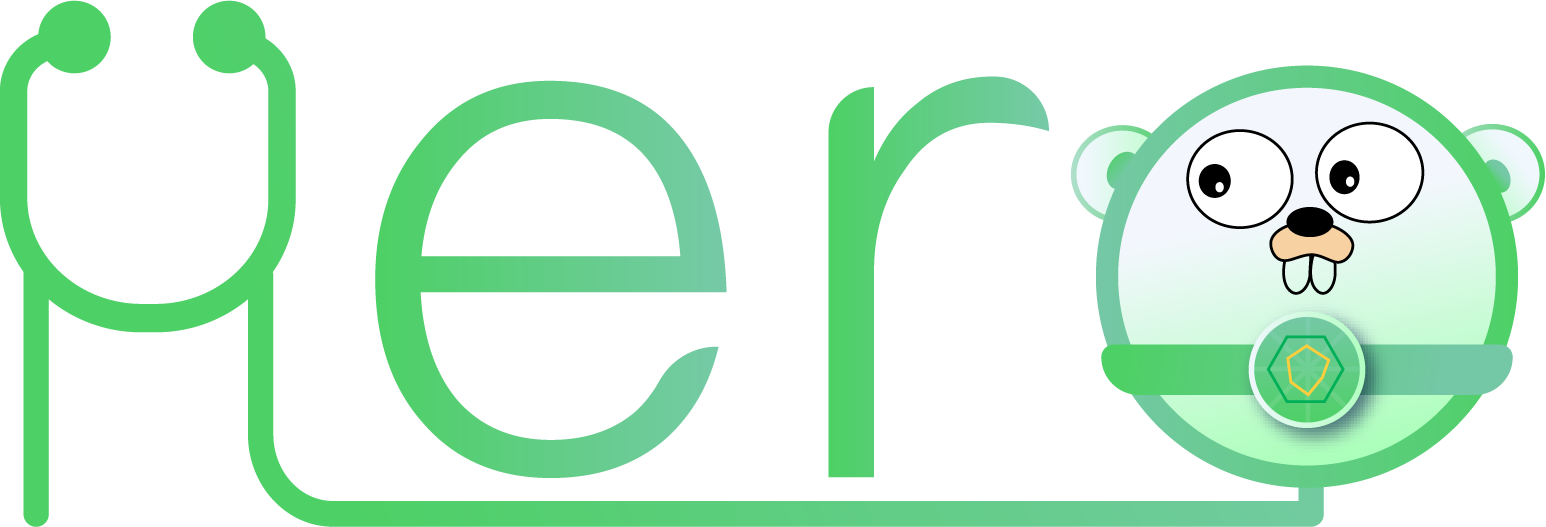-




























 How Hero+ works?Dependency Management Issue DiagnosisBuilding a healthy Golang ecosystemDiagnose
How Hero+ works?Dependency Management Issue DiagnosisBuilding a healthy Golang ecosystemDiagnose
-
Help
× 1. Input the name and version tag number of your Go project released on GitHub.
2. Press the "Start" button, we will provide the dependency graph, then help you diagnose the dependency conflict issues in your project and provide the detailed root causes and suggested fixing solutions. In addition to version tag number, you can also input the commit hash code of your project.
In addition to version tag number, you can also input the commit hash code of your project. heroAnalyzing... The process may take you several minutes.Most functions are working, while some are under tuning for performance...
heroAnalyzing... The process may take you several minutes.Most functions are working, while some are under tuning for performance...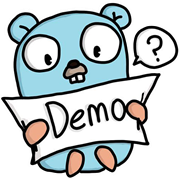 StartDependency Model
StartDependency Model -
Table Statistics of Dependency Management Issues Reported by HERO and HERO+ Status 1: Issues fixed using our suggestions; Status 2: Issues under fixing using our suggestions; Status 3: Issues confirmed, but fixing not decided; Status 4: Issues fixed using other suggestions; Status 5: Issues pending; Issue ID ♠: Migration to Go Modules conducted (desired); ID Project Name Issue ID Issue Type Issue Status -
-
Components of the Dependency Model
The dependency model is built using three core components: vr, mo, and pj. Each component focuses on different aspects of the project, such as versioning, module information, and GOPATH-related details.
1. vr = (v, st, pt) records information of a version:
v: The exact version number.
st: The time and checksum of v on the hosting site.
pt: The time and checksum of v on GOPROXY.
2. mo = (mp, S, rp, sub) records information about a module:
mp: Module path used for downstream referencing.
rp: Collection of replace directives used in the go.mod file.
S: Indicates if the module is released using the major branch strategy.
sub: Describes the role of the module within a multi-module project (e.g., root or submodule).
3. pj = (mp, t, vd, ip) records information related to a Golang project:
mp: Module path used for downstream referencing.
t: Indicates dependency management tool usage (yes/no).
vd: Import paths referencing missing upstream libraries in the vendor directory.
ip: Import paths for libraries referenced in source files.
Dependency Model Definition
The model is formally defined as a 3-tuple: 𝒟(Pv) = (Pr, Ds, Us), where:
1. Pr = (vr, md, mos, pj) records the information of the current project:
vr: Version information of the project.
md: Library-referencing mode (GOPATH or Go Modules).
mos: The modules’ information in the project (if in Go Modules).
pj: GOPATH related information (if in GOPATH).
2. Ds = {dp1, dp2, · · · , dpn} represents a collection of Pv's downstream projects dpi:
vi: Latest version of the downstream project.
mdi, moi, pji: Mode and information specific to Go Modules/GOPATH projects.
3. Us = {up1, up2, · · · , upn} represents a collection of Pv's upstream projects upi:
vri: Version of upi referenced in the current project.
mdi, moi, pji: Mode and information specific to Go Modules/GOPATH projects.
Ii: Indicates if upi is transitively included via a GOPATH project. -
Scenarios for which Hero+ reports issues:
Type A:

Figure (a) shows a scenario, where a module-unaware project Pv references a specific version of its upstream project upa in Go Modules. This version is older than upa’s latest version, which newly introduces another upstream project upb in Go Modules with a v2+ version released using the major branch strategy. Build errors do not occur in Pv when it references upa’s old version. However, if Pv updates upa to reference the latest version, it will not be able to recognize upb’ s virtual import path. When seeing such a possibility, Hero+ reports a warning of Type A issue for Pv .
Type B.1:

Figure (b) shows a scenario, where project Pv in Go Modules transitively references a v2+ upstream project upb in Go Modules (released by the major branch strategy) through another module-unaware project upa in GOPATH. Since GOPATH and Go Modules interpret import paths differently, upa would use upb’s latest version (e.g., v2.0.0), while Pv would use upb’s old v0/v1 version, causing inconsistencies. Thus, Hero+ reports a warning of Type B.1 issue for Pv .
Type B.2:

Figure (c) shows a scenario, where project Pv in GOPATH references an upstream project upa maintained only in its Vendor directory (i.e., upa has already been deleted or relocated). No build errors occur when Pv has no downstream projects in Go Modules. However, if Pv has such downstream projects, the latter would fetch upa via its import path (i.e., hosting repository) rather than from Pv’s Vendor directory, causing build errors due to failing to fetch upa . Thus, Hero+ reports a warning of Type B.2 issue for Pv .
Type C.1:

Figure (d) shows a scenario, where project Pv in Go Modules violates SIV rules. The violation may not introduce build errors when Pv has no downstream projects in Go Modules. However, build errors would occur if such projects exist in future. Thus, Hero+ reports a warning of Type C.1 issue for Pv .
Type C.2:

Figure (e) presents a case where the project upa in Go Modules violates the rules of the replace directive. Specifically, upa declares a dependency on upc through a replace directive. However, due to the non-inheritance of replace directives, Pv erroneously depends on upb. While this violation may not immediately trigger build failures when Pv interacts with the dependency, such errors are likely to manifest as upa undergoes updates. Consequently, Hero+ identifies and classifies this as a Type C.2 issue for Pv.
Type C.3:

Figure (f) illustrates a scenario where project upa was initially a single-module project in version v1.0.0, with upa/sub as a package within upa. In version v2.0.0, upa splits upa/sub into a standalone submodule. As a result, Pv, using Go Modules, simultaneously depends on upa at version v1.0.0 and on the split submodule upa/api at version v2.0.0. This duplication introduces potential build failure because of ambiguous import. Therefore, Hero+ flags this situation as a Type C.3 issue for Pv.
Type C.4:

Figure (g) depicts a scenario where project Pv re-releases a tag, resulting in inconsistencies between version v1.0.0 of Pv on GitHub and GOPROXY. If downstream projects fetch dependencies directly from GitHub, this inconsistency may lead to build failures in those downstream projects. Consequently, Hero+ raises a Type C.4 issue warning for Pv.
Detection process:
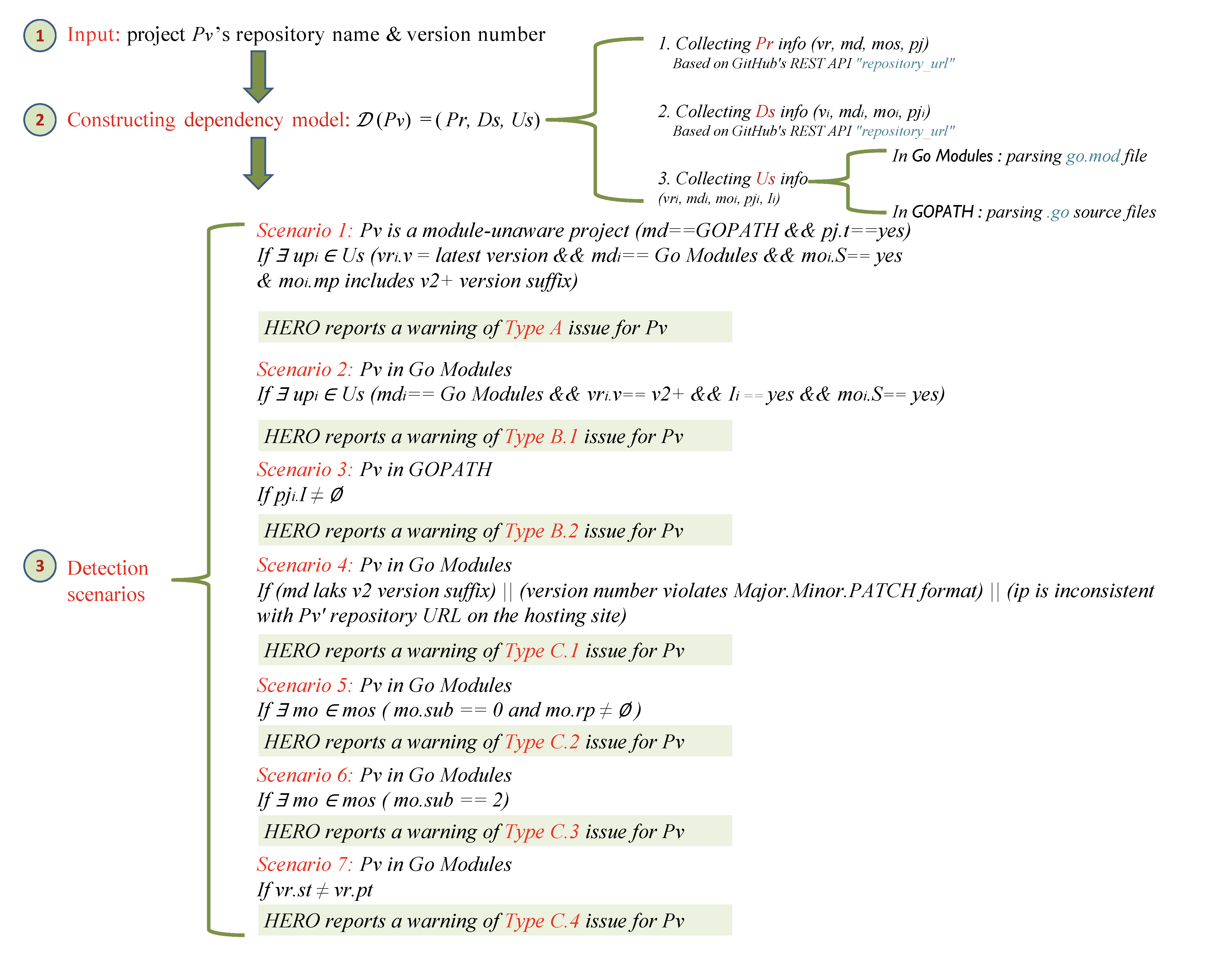
Note:
1. REST APIs "repository_url" and "code_search_url" are defined by GitHub Rest API v3
standards(https://developer.github.com/v3/) ;
2. Si denotes whether upi is released by the major branch strategy (yes or no)
3. Ii denotes whether upi is transitively introduced into Pv by any project in GOPATH (yes or no)
4. vd denotes a collection of import paths (set of URLs) referencing those upstream libraries that are maintained in
Pv’s Vendor directory but cannot be found in the repositories pointed to by URLs (e.g., due to removal or
renaming); -
For each detected DM issue, Hero+ suggests all applicable solutions to developers by customizing the template with potential impact analysis based on the associated dependency model.
Templates of customized fixing suggestions for three types of DM issues are described as follows, where Pv is the project under analysis; mbs is short for the major branch strategy; mss is short for the major subdirectory strategy; "S1-8" denote fixing solutions 1-8; ab1-3 and uc1-4 correspond to the additional benefits and undesired consequences of fixing solutions; info is the customized information by Hero+.
Fixing Type A DM issues
S1→Let Pv migrate to Go Modules
ab1: Promoting the migration to Go Modules;
uc1: Breaking compatibility with Pv’ s downstream module-unaware projects: dp1 , dp2 ,…, dpn ∈ Ds (in GOPATH and using DM tools);
S2→Let Pv’ s v2+ upstream project upi (in Go Modules and released by mbs) roll back to GOPATH
ab2: Supporting upi’ s downstream module-unaware projects;
uc2: Hindering the migration to the ecosystem;
S3→Let Pv’s v2+ upstream project upi in Go Modules change its releasing strategy from mbs to mss
ab2: Supporting upi’ s downstream module-unaware projects;
uc3: Increasing maintenance efforts;
S4→Let Pv maintain v2+ upstream project upi (in Go Modules, released by mbs) in Vendor directory uc3: Increasing maintenance efforts;
uc4: Introducing potential DM issues in future;
Fixing Type B.1 DM issues
S5→Let Pv reference upstream project upi using a replace directive with upi’ s latest version number to avoid using its problematic import path
uc3: Increasing maintenance efforts;
Note: upi is a v2+ project in Go Modules (release by mbs), and transitively referenced by Pv through another module-unaware upstream project
Fixing Type B.2 DM issues
S6→Let Pv update import path for its upstream project upi that has changed its hosting site names
ab3: Supporting Pv’s downstream module-aware projects: dp1, dp2,…, dpn ∈ Ds(in Go Moules);
Fixing Type C.1 DM issues
S2→Let Pv roll back to GOPATH
ab2: Supporting Pv’ s downstream module-unaware projects: dp1, dp2,…, dpn ∈ Ds (in GOPATH and using DM tools);
uc2: Hindering the migration to the ecosystem;
S5→Let Pv’ s downstream projects dpi (in Go Modules) use a replace directive with version number v to avoid using Pv’ s problematic import path
uc3: Increasing maintenance efforts;
S7→Let Pv fix its configuration items to strictly follow SIV rules
ab3: Supporting Pv’s downstream module-aware projects: dp1, dp2,…, dpn ∈ Ds (in Go Moules);
uc1: Breaking compatibility with Pv’s downstream module-unaware projects: dp1, dp2,…, dpn ∈ Ds (in GOPATH and using DM tools);
S8→Let Pv’s downstream projects upi (in Go Modules) use a hash commit ID corresponding to version Pv to replace its problematic version number
uc3: Increasing maintenance efforts.
Fixing Type C.2 DM issues
S5→Let Pv add upi’’s replace directive usage to its go.mod
uc3: Increasing maintenance efforts;
uc4: Introducing potential DM issues in future;
S9→Let Pv’’s upstream project upi (in Go Modules) eliminate the usage of replace directive
ab3: Supporting all Pv’s downstream projects: dp1, dp2,…, dpn ∈ Ds;
ab3: Supporting all Pv’s downstream projects: dp1, dp2,…, dpn ∈ Ds;
Fixing Type C.3 DM issues
S10→Let Pv adhere to the rules of multi-module publishing
ab3: Supporting Pv’s downstream module-aware projects: dp1, dp2,…, dpn ∈ Ds (in Go Modules);
S11→Let Pv adjust the version of upi’s root module
uc4: Introducing potential DM issues in future;
uc4: Introducing potential DM issues in future;
Fixing Type C.4 DM issues
S11→Let Pv adjust the version of upi
uc4: Introducing potential DM issues in future;
S12→Let Pv release a new version for a bug-fix release
ab3: Supporting Pv’s downstream module-aware projects: dp1, dp2,…, dpn ∈ Ds (in Go Modules);
S13→Let Pv clean mod cache and avoid using GOPROXY
uc4: Introducing potential DM issues in future;
Currently maintained by Ying Wang at Northeastern University and Chang Xu's SPAR Group at Institute of Computer Software, Nanjing University -
